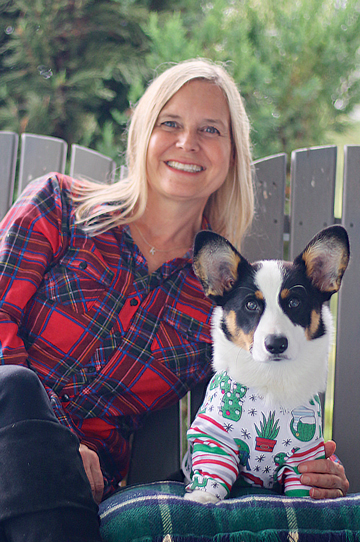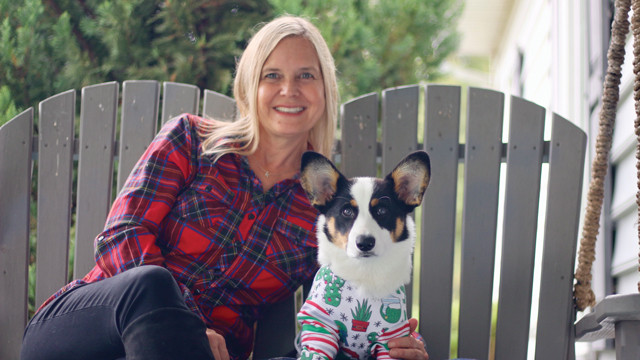Is a puppy on your holiday list? With a year like 2020, I think we are all looking for ways to make up for a challenging year of struggles and mixed blessings.
My family knows first-hand the joys and realities of owning a pet. We lost our beloved bulldog at the start of the pandemic and along with him, a little piece of our heart! So our teenage son researched breeds, watched videos, called breeders, and made a proposal on why a Corgi would be a good fit for our family. The next thing we knew, he had saved half the money, and we were counting down the days until we brought Rigley home.
Now that we are a few months into the puppy stage, I want to share what you can expect cost-wise when bringing a new dog into your home so there are no financial surprises. According to the American Society for the Prevention of Cruelty to Animals, the first-year cost of a dog exceeds a thousand dollars. Whether you’re adopting from a rescue organization or buying from a breeder, here’s a breakdown of the expenses and a few tips to ensure your pet is well cared for and that the only surprise for your family is the one of delight when you meet your puppy for the first time.
 1. Adoption Fees
1. Adoption Fees
Depending on whether you want a pure-bred puppy from a breeder or a rescue puppy, the cost can range from $75 to thousands of dollars. Rescue adoptions can sometimes include veterinary fees, which can save on initial costs. A shady breeder could mean a greater chance of health problems. Be careful of puppy mills or suspicious ads selling so-called pure-bred puppies. According to The Humane Society, there are 10,000 puppy mills active in the United States.
2. Home Preparation
Just like babies, curious puppies cannot be left alone and will need a safe place to sleep or stay when unsupervised. The American Kennel Club suggests crate training dogs for safety (of pets and property) and house training. Crate training has worked like a charm for Rigley. We purchased a used crate for $25 through Facebook Marketplace. Some families may want a more expensive crate that looks like a piece of furniture and for others, a metal crate will work just fine. Your best bet is to get a crate that folds for travel and has a detachable divider that lets it grow with your puppy. As for size, you want your dog to be able to stand up and turn around while in the crate. A rule of thumb is to measure your dog and add four inches. Depending on whether you go new, used, or one that blends in with your furniture, costs can range from $25 to hundreds of dollars.
3. Veterinary Visits
The average lifespan of a dog is ten to thirteen years, therefore you’ll want and need a vet to support you through all the stages of your dog’s life. Our dog’s breeder required that we set up a vet visit within two days of bringing Rigley home, therefore we had four visits between eight and sixteen weeks to ask questions and get our puppy up to speed on vaccinations and milestones. Although costs will vary by vet, medical costs are one of the most expensive aspects of owning a pet. You can expect to pay upwards of $500 total for those early puppy visits plus an additional $200 or more to have your dog spayed or neutered within the year.
Another option is to check with some of the larger pet stores that offer a monthly puppy plan that includes exams, vaccinations, diagnostic testing, neuter surgery, and unlimited office visits at a discounted price.
And this is just to get them through the puppy stage. Pets also need regular check-ups, vaccines, monthly preventative medicine (heartworm, plus flea and tick prevention, runs about $30 a month), and those unexpected emergencies.
4. Food and Treats
Investing in high-quality treats and pet food affects your pet’s health, energy level, and overall well-being. Ideally, you would want to look for a food that includes minimally processed ingredients. Mid-range dog food brands will cost $250 to $700 a year, depending on the brand of food and size and weight of the dog.
5. Fencing
This is an expense that will make your life with a pet a lot more convenient and potentially safer for your dog, your family, and your neighbors. Electric fences can be a more affordable option. Depending on size and style, fences can range from just under $1,000 to more than $5,000.
6. Grooming
Does your dog need haircuts, teeth cleaning, bathing, or its nails trimmed? All this can be done at home if you are willing to take the time, learn the skills, and purchase a few tools. Or maybe you want to treat your pup to a spa day for $40 to $75 (based on its size). If getting your dog to and from the groomer is a problem, there are even dog groomers that can come to you.
And if you have a shedding dog like a Corgi, which has a thick, dual-layer coat, you may not have to worry about haircuts, but you might want to invest in a good dog brush and a Roomba or other high-powered vacuum.
7. Training
At twelve weeks, our vet suggested a puppy socialization class for Rigley. We opted to skip this step to save a little money because we had time at home to work on training and socialization. We have had a good start teaching Rigley basic tricks, but will need some help from the experts when it comes to listening, jumping, barking, chewing, digging, and biting. Corgis are smart dogs, but like many, they can be smarter than their human, so expert and consistent training pays off down the road.
With our bulldog, we had a few private lessons in the comfort of our home because there were some issues we needed to direct personal attention to in our home environment. There are more economical training opportunities with group lessons or virtual training. I found that posting a question on Facebook gave me several good recommendations as a starting point. A basic 6-week class at a local pet store starts at $149 and goes up from there.
8. Travel
After four months of constant supervision and training your puppy, both of you may be ready for a vacation. The average overnight cost to board a dog is $40 a night. The costs add up, but it’s important to find a reputable boarding facility that you can trust while you are away.
If you can’t bear to separate from your furry friend and want to take your pet along with you, the sky’s the limit with planes, trains, automobiles, RVs, hotels, and house rentals. Expect to pay additional pet rental fees from $20 to $100 per night. Check out bringfido.com for pet-friendly hotels, restaurants, activities, and events.
Pets play a special role in family life and making this decision is so much bigger than filling a spot on a Christmas wish list. Those cute little puppies come with a lifetime of commitments that extend far beyond the holiday season. But if you go into this decision knowing what to expect, you can prioritize what is most important, look for areas to save, and help your family enjoy the amazing benefits of being a pet owner.
Photo: Luke Tschantre





